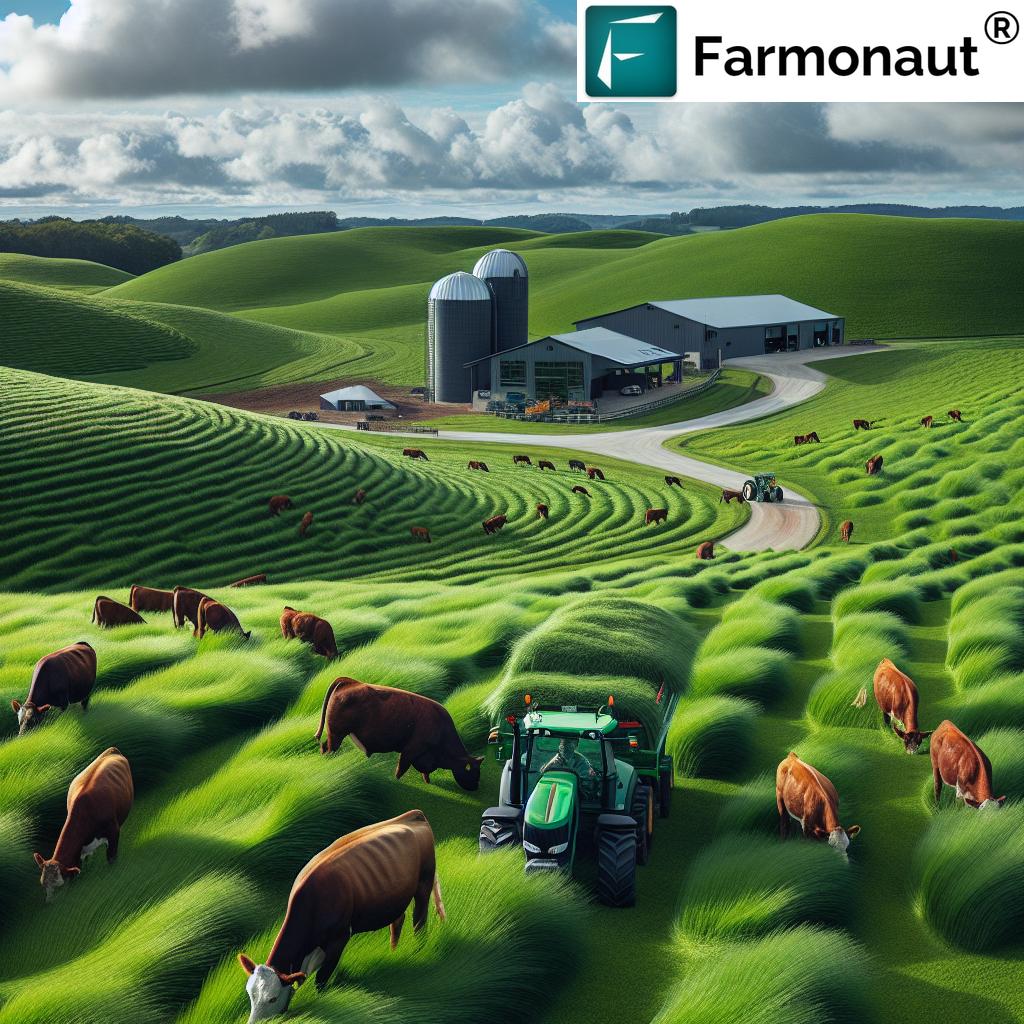Table of Contents
- Introduction: Which Action Allowed Farming to Expand into West Texas?
- Historical Challenges: West Texas’s Arid Landscape
- The Game-Changer: Ogallala Aquifer and Groundwater Irrigation
- Revolutionizing Water Use: Drip Irrigation Systems
- Breakthroughs in Crop Science: Drought-Tolerant Varieties
- Soil Management and Sustainable Practices
- Comparative Technology Impact Table
- Infrastructural and Policy Support
- Farmonaut Solutions for Modern Agriculture
- Looking Forward: The Future of West Texas Agriculture
- FAQ: Which Action Allowed Farming to Expand into West Texas?
- Farmonaut Subscription Options
“Advanced irrigation increased West Texas farmland by over 200% between 1950 and 1980, revolutionizing regional agriculture.”
Which Action Allowed Farming to Expand Into West Texas? Unveiling Technological Innovations
Which action allowed farming to expand into West Texas? This question sits at the heart of the region’s remarkable agricultural transformation. Historically, West Texas was viewed as unarable, with limited rainfall, challenging soil conditions, and an arid climate that made extensive farming a risky endeavor. However, starting in the mid-20th century and continuing into 2025, innovative adaptations, advanced irrigation techniques, and drought-resistant crop varieties have transformed the region into a hub of productive agriculture.
In this comprehensive guide, we’ll explore the key action that enabled this agricultural evolution, including a deep dive into groundwater and drip irrigation, the Ogallala Aquifer, modern crop science, sustainable land management practices, and the technological breakthroughs propelling West Texas farming into 2025 and beyond. Our focus addresses not only historic change, but also spotlights cutting-edge advancements shaping the present and future of agriculture in this challenging region.
Historical Challenges: West Texas’s Arid Landscape and Agricultural Limitations
West Texas lies at the intersection of opportunity and adversity. The region is known for its semi-arid environment, low rainfall, intense heat, and fragile soil. For much of its history, these factors limited farming to small-scale, high-risk operations dependent on the unpredictable bounty of natural precipitation.
- Soil Conditions: West Texas soil is often thin and sandy, challenging crops to access moisture and nutrients.
- Rainfall: Average annual rainfall in the heart of West Texas is less than 20 inches, compared to 40+ inches in East Texas.
- Climate Extremes: Summers bring intense heat, quickly depleting soil moisture and threatening tender plants.
- Dryland Farming: Traditionally, farmers used dryland practices—growing only what the weather could support, facing risk of failure in drought years.
Given these barriers, it’s evident why the expansion of farming into West Texas required a major breakthrough—a technological leap that could bring water to crops, manage soil moisture, and ensure consistent yields despite environmental volatility.
The Game-Changer: Which Action Allowed Farming to Expand Into West Texas? Groundwater Irrigation & the Ogallala Aquifer
Which action allowed farming to expand into West Texas? The single most pivotal answer is the development and widespread adoption of advanced groundwater irrigation. This breakthrough fundamentally transformed the region’s agricultural history.
The Ogallala Aquifer: West Texas’s Lifeline
Let’s explore the Ogallala Aquifer—an underground reservoir stretching beneath much of the High Plains, including West Texas. The aquifer is one of the largest freshwater sources in North America.
- Lies Beneath: Extends below 8 states, including Texas, covering roughly 174,000 square miles.
- Groundwater: Provides a massive underground water source—a key natural resource in a dry region.
- Wells and Pumping: From the 1940s onward, farmers and ranchers began drilling wells to pump water to the surface for irrigation.
This action enabled agriculture to expand into once considered marginal and largely unarable zones. It converted barren prairie into a patchwork of productive farmland.
How Did Groundwater Irrigation Revolutionize Farming?
- Irrigation on Demand: Farmers could irrigate crops when rainfall was scarce, supplementing natural water sources.
- Variety of Crops: Allowed for the cultivation of cotton, corn, wheat, sorghum, and many other crops—all with greater reliability and higher yields.
- Longer Growing Seasons: Extended the growing season, increasing the number of productive cycles per year.
With this technological leap, what was once a risky endeavor became a sustainable, high-yield activity.
Groundwater irrigation and the exploitation of the Ogallala Aquifer were the first major answers to the question, “Which action allowed farming to expand into West Texas?”
Revolutionizing Water Use: What Was a New Technique Used to Expand Agriculture into West Texas? The Rise of Drip Irrigation
As we entered the 21st century, drip irrigation emerged as a new technique used to expand agriculture into West Texas. The evolution from basic groundwater pumping towards precision irrigation is one of the most critical actions for regional sustainability.
- Water Efficiency: Unlike traditional flood or furrow irrigation, drip irrigation systems deliver water directly to the plant root zone, minimizing evaporation losses and maximizing use.
- Advanced Control: Automation and soil moisture sensors allow precise control over irrigation schedules, reducing water waste and supporting sustainable farming practices.
- Critical in Arid Areas: In West Texas’s arid climate, this modern technique is a game-changer for productivity.
- Combined Approaches: Today, most successful farms apply a combination of well irrigation (drawing from the Ogallala Aquifer) and drip or subsurface irrigation systems for maximum efficiency.
Why Drip Irrigation? Profile of an Innovation
- Delivers water precisely where needed, reducing evaporation losses—a must for arid zones.
- Reduces salinization by keeping the upper soil dry and minimizing overwatering.
- Lowers weed pressure as water is limited to the root zone of crops.
- Can be automated for exact timing and frequency, ensuring each crop gets the moisture it needs.
What was a new technique used to expand agriculture into West Texas? In summary, it’s advanced drip irrigation technologies combined with groundwater pumping that have pushed West Texas farming into an era of higher productivity and sustainability.
For developers seeking real-time agricultural monitoring and advanced water management APIs, check out Farmonaut’s Agri Data API and API Developer Docs.
“Drought-tolerant crops boosted West Texas crop yields by up to 40% after their introduction in the late 20th century.”
Breakthroughs in Crop Science: Drought-Tolerant Crop Varieties in West Texas
The expansion of farming into West Texas didn’t depend on irrigation alone. Another key action was the development and adoption of drought-resistant and heat-tolerant crop varieties. This revolution in crop genetics has enabled sustainable farming in one of America’s toughest environments.
- Selective Breeding and Biotechnology: Scientists and agriculturalists developed crop varieties that withstand longer dry periods and high temperatures.
- Reduced Risk: These cultivars can survive prolonged droughts, making output more stable even in volatile weather years.
- Examples: Drought-tolerant cotton and deep-rooted sorghum hybrids now thrive in West Texas.
- Combined: These innovative plants complement advances in irrigation, further increasing yields and resilience across the region.
In 2025 and beyond, introducing new crop varieties designed for climate resilience continues to be essential for sustained farming expansion in West Texas.
Sustainable Soil Management and Conservation Practices
Land management is as vital as irrigation or crop genetics. As the question “which action allowed farming to expand into West Texas?” implies, there’s no single magic bullet; combinations of innovations have underpinned the region’s steady progress.
- No-Till Farming: Retains soil moisture and organic matter by minimizing disturbance to the soil structure.
- Cover Cropping: Keeps the field “alive” between main crops, preventing erosion and improving fertility.
- Crop Rotation: Alternates crop types for soil health, reducing pests, and maintaining nutrient balance.
These conservation practices help preserve precious soil and moisture, ensuring that intensive irrigation and advanced crop varieties yield sustainable, long-term results.
If you want an in-depth understanding of soil health and its foundational role, watch:
We recommend utilizing modern agriculture advisory platforms to monitor and optimize soil health and input management. Regular crop monitoring and soil analysis—such as those provided by Farmonaut’s satellite-based crop health monitoring solutions—can help maximize yield while minimizing environmental impact.
Farmonaut’s Carbon Footprinting Tool enables agribusinesses to actively track, manage, and reduce their carbon footprint, supporting soil health and overall sustainability across the farm landscape.
Comparative Technology Impact Table: Agricultural Innovations in West Texas
| Innovation | Year of Introduction (Estimated) | Water Usage Reduction (%) | Yield Improvement (%) | Adoption Rate (% by 2024, Estimated) |
|---|---|---|---|---|
| Groundwater Pumped Irrigation (Ogallala Aquifer) | 1940s–1950s | 30% | Up to 200% (cumulative from expansion of acreage/irrigation) | ~90% |
| Drip Irrigation Systems | 1970s–1980s | Up to 50% | 20–40% | ~40% |
| Drought/Heat-Tolerant Crop Varieties | 1980s–present | 15% | Up to 40% | ~75% |
| Sustainable Soil & Land Management Practices* | 1990s–present | 10-20% | 10–20% | ~60% |
*Including no-till, cover cropping, and mainstream crop rotation
Infrastructural and Policy Support for Farming Expansion
Alongside technical advances in irrigation, crop science, and land management, the rapid expansion of farming into West Texas has been supported by robust infrastructure and responsive government programs. These measures are essential for maximizing the long-term benefits of technological innovations.
- State and Federal Programs: Research grants, farmer subsidies, and conservation initiatives encourage rapid adoption of sustainable practices and cutting-edge equipment.
- Infrastructure Investment: Road improvements, transport networks, and irrigation distribution systems streamline the journey from farm to market.
- Data-Driven Agriculture: Government and private sector partners support the integration of precision agriculture platforms for real-time AI-based monitoring and resource optimization.
It’s clear that farming expansion in West Texas is a tapestry of actions and innovations—with groundwater and drip irrigation at its core, but equally dependent on supportive policy and reliable infrastructure.
Explore Farmonaut’s Blockchain Product Traceability solution, enhancing supply chain transparency for crops and increasing market access for West Texas farmers.
Farmonaut Solutions for Modern Agricultural Management in West Texas
Precision technologies have become essential in optimizing the use of irrigation infrastructure, monitoring soil moisture, and ensuring resource conservation in challenging climates such as West Texas. At Farmonaut, we empower farmers and agribusinesses to enhance productivity, sustainability, and profitability via data-driven, satellite-powered advisory systems developed explicitly for modern agriculture.
- Satellite Crop Monitoring: Our platform delivers frequent, multispectral satellite data on vegetation health, soil moisture, and crop vigor—enabling farmers to detect stress, plan irrigation, and apply inputs at the right time and place.
- Jeevn AI Advisory System: Personalizes farm management strategies using weather data, soil condition assessments, and local analytics. This directly supports improved yields and smarter water management, especially crucial for farming in arid regions such as West Texas.
- Carbon Footprinting: Track and reduce farm-level carbon emissions for environmental compliance and consumer trust. See more at our carbon footprinting portal.
- Blockchain Traceability: Provenance assurance for crops, cotton, or food products—bolstering transparency in high-value supply chains. Learn about our traceability solution.
- Fleet and Resource Management: For large and mid-sized farms, efficient logistics and equipment utilization via web and mobile dashboards. Read more at our fleet management page.
- Loan & Insurance Verification: Satellite-based field verification enhances trust for crop loans and insurance assessments. See details at our crop loan & insurance section.
- Scalable Administration: State-level and large-scale farm administration tools are available on our dedicated Large Scale Farm Management Platform.
- Advisory for All: Our technology is accessible to smallholders, large agribusinesses, and government programs, further democratizing data-driven agriculture worldwide.
If you are interested in plantation or forest advisory for Texas or other regions, our end-to-end satellite–driven plantation and advisory platform can accelerate your success.
Looking Forward: The Future of Farming Expansion in West Texas (2025 & Beyond)
What does the future hold for West Texas agriculture? The expansion of farming will continue to depend on advanced irrigation, sustainable land and crop management, and the creative application of technology. However, new concerns and opportunities are already shaping the region’s outlook to 2030 and beyond.
- Aquifer Depletion: Unsustainable groundwater extraction threatens the Ogallala Aquifer. New surface water harvesting, rainwater catchment, and wastewater reuse strategies are being piloted alongside smart irrigation systems.
- Renewable Energy Integration: Solar-powered pumps and energy-efficient automation cut costs and greenhouse gas emissions from groundwater extraction.
- AI and Satellite Analytics: Next-gen farm management platforms—such as those provided by Farmonaut—will become the norm, delivering farm-level insights for every acre, every day.
- Climate-Smart Crops: Ongoing research will introduce varieties with better drought and disease resistance for further resilience in a warming world.
In sum: The action that allowed the expansion of farming into West Texas has been the continual, combined adoption of advanced irrigation systems, sustainable land management, and climate-adapted crop genetics—supported by technological innovation, data-driven intelligence, and policy infrastructure.
FAQ: Which Action Allowed Farming to Expand Into West Texas?
Q1. Which action allowed farming to expand into West Texas?
The most pivotal action was the development and widespread adoption of advanced irrigation techniques, especially groundwater pumping from the Ogallala Aquifer. Combined with the introduction of drip irrigation systems, drought-tolerant crop varieties, and sustainable land management practices, these innovations transformed West Texas from an arid landscape into a productive agricultural region.
Q2. What is the Ogallala Aquifer, and why is it important to West Texas agriculture?
The Ogallala Aquifer is a vast, underground reservoir of freshwater stretching beneath the Texas High Plains and several other states. Its exploitation via deep wells and pumped irrigation enabled reliable, on-demand water access—supporting consistent crop growth in an area historically defined by water scarcity.
Q3. What was a new technique used to expand agriculture into West Texas?
Drip irrigation stands out as a new, water-saving technique used to expand agriculture in the region. This method delivers water directly to the plant root zone, minimizes evaporation losses, and improves overall water use efficiency—vital for the arid West Texas environment.
Q4. Are these methods sustainable for the future?
Many of these techniques—particularly drip irrigation and sustainable land management—are highly sustainable. However, over-extraction of groundwater remains a challenge. Ongoing research, renewable-powered irrigation, and integrated smart farm management systems will be essential for continued productivity in the decades ahead.
Q5. How can technology like Farmonaut help West Texas farmers?
Farmonaut’s satellite-powered platform gives farmers real-time insights into crop health, soil moisture, weather, and resource use. This helps optimize irrigation schedules, reduce input use, improve yields, and support regenerative environmental practices. It is accessible via web, Android, and iOS apps.
Q6. What is the outlook for West Texas farming beyond 2025?
The future of farming in West Texas will rely on integration of advanced irrigation systems, AI-powered resource management, new crop genetics, and sustainable conservation practices. Continued research and data-driven technologies will be crucial for maximizing productivity and environmental stewardship.
Farmonaut Subscription Options
Start your precision agriculture journey with Farmonaut:
Conclusion: The Actions That Transformed West Texas Farming
The story of farming expansion in West Texas is a testament to the power of innovation, determination, and adaptation to a harsh environment. The central answer to which action allowed farming to expand into West Texas is a mix of advanced irrigation (the Ogallala Aquifer and drip systems), drought-tolerant crops, and modern sustainable practices.
The combined effect of these technological advancements has transformed West Texas from a marginal, largely unarable area into a productive, sustainable agricultural powerhouse. If you want to harness these innovations for your farm, explore how Farmonaut can help you monitor, manage, and maximize your land’s potential through affordable precision agriculture solutions.













